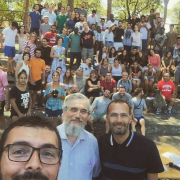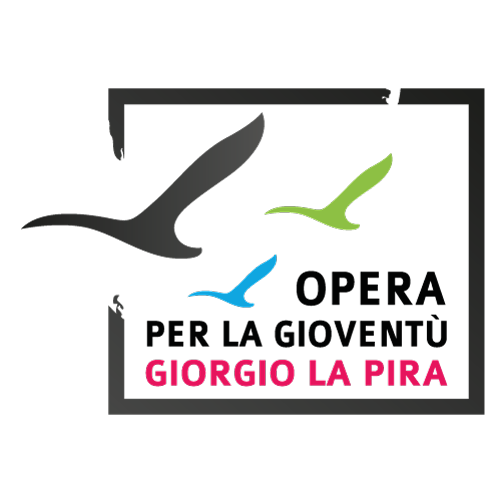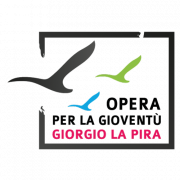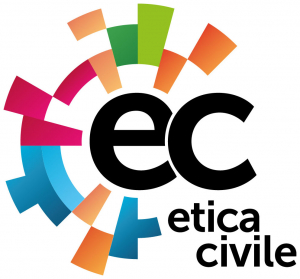L’attività internazionale ed il Campo Internazionale a La Vela
La presenza del Professor Giorgio La Pira tra i giovani dell’Opera ha esercitato una notevole influenza nell’allargare l’orizzonte della loro formazione e approfondire i contenuti delle loro attività: tutta l’attività internazionale dell’Opera, da Pino Arpioni fortemente voluta e tenacemente portata avanti negli anni, ha certamente nel pensiero e nell’azione del professore il suo punto di riferimento.
L’impegno per l’unità dei popoli e delle nazioni trova il suo presupposto nel cammino di unità della Chiesa: da qui una particolare sensibilità per il cammino ecumenico, vissuto in particolare nell’incontro fra giovani.
E’ proprio dalla dimensione ecumenica, dunque, che parte questo importante aspetto del servizio educativo dell’Opera.
Nel novembre 1979 con il viaggio a Londra, guidato dal Card. Giovanni Benelli, Arcivescovo di Firenze, si aprirono i rapporti con la Chiesa Anglicana: vi fu l’incontro con l’Arcivescovo di Canterbury e la comunità della Chiesa Universitaria del Cristo Re di Londra ospitò una Liturgia ecumenica. Dall’anno successivo, l’Opera per alcuni anni ospitò a La Vela i giovani anglicani.
Già da queste prime esperienze emergono gli elementi essenziali anche di tutto il cammino successivo: l’unità si costruisce anzitutto con l’incontro e nell’amicizia.
Ecco le parole di padre Peter Hughes, anglicano, animatore di questi primi incontri: “Il tema del nostro primo incontro a La Vela nell’agosto 1980, trattando dell’unità dei cristiani come segno e strumento dell’unità di tutto il genere umano, si ispirò alla Lumen Gentium. L’impegno per la pace del mondo richiede l’impegno per l’unità e la pace fra gli stessi cristiani. Poi, la convinzione guida che l’ecumenismo pratico parte dall’incontro per conoscersi meglio, e dall’amicizia, fu in piena sintonia con gli sviluppi post-conciliari, e con la filosofia dell’Opera che si ispira dalla figura meravigliosamente accogliente di La Pira, e di Pino, gentile e persistente, ospite generoso, che ebbe il coraggio insieme con i suoi collaboratori di aprire l’Opera ad un’esperienza nuova e trasformatrice. Fondamentale, dunque, fu l’incontro. Noi esseri umani abbiamo bisogno l’uno dell’altro per intravedere il movimento del divino nel nostro presente. Gli evangelisti testimoniano che non c’è nessun altro luogo in cui Dio è più “visibile” se non nel cuore dell’altro che ci accoglie nell’abbraccio amoroso e fiducioso (Ma essi insistettero: “Resta con noi perché si fa sera… Lc 24, 29.…dove sono due o tre riuniti nel mio nome, io sono in mezzo a loro… Mt 18, 20). Ciò che avvenne dall’incontro fu sempre dono sorprendente della grazia.”
L’esperienza si è poi allargata, dal 1986, anche a giovani della Chiesa Ortodossa Greca, in particolare della Diocesi del Pireo e a giovani cattolici del Portogallo (la nazione di Fatima, l’altro pilastro del “ponte di preghiera, unità e pace tra oriente ed occidente” immaginato da La Pira).
Particolare rilievo hanno assunto, a partire da quegli anni, gli incontri tra i giovani italiani e russi.
Nel 1984 l’Opera prese infatti l’iniziativa di celebrare il 25esimo anniversario del primo viaggio in Russia del prof. Giorgio La Pira recandosi a Mosca, Zagorsk, Leningrado e Kiev con un gruppo di cento giovani dopo aver definito con le autorità dell’URSS un nutrito programma di incontri a livello politico, sociale e religioso.
L’iniziativa fu tanto innovativa e di così reciproca soddisfazione da suggerire di ripeterla periodicamente fino ad oggi, pure in un contesto sociale, culturale e politico completamente diverso.
In particolare negli anni del cambiamento indotto da Mikhail Gorbaciov (che, ospite dell’Opera, ricordò La Pira a Roma in occasione del Giubileo dei governanti e dei parlamentari del 5 novembre 2000) i rapporti si intensificarono ulteriormente anche nella constatazione di significative convergenze di tipo culturale sull’idea della costruzione in Europa di una “Casa comune” in cui tutti i popoli di oriente ed occidente potessero trovare il loro luogo naturale di incontro.
In questo quadro si inseriscono anche i consolidati rapporti con la Chiesa Ortodossa Russa, sia a livello ufficiale con il Patriarcato di Mosca, sia a San Pietroburgo nella consapevolezza, come cristiani, di dover “respirare con due polmoni”, quello del cristianesimo di oriente e quello del cristianesimo di occidente, secondo l’efficace immagine di Giovanni Paolo II.
Fin dal 1986 si rese possibile anche un viaggio in Italia dei giovani russi incontrati nelle diverse occasioni; nel corso degli anni si è perfezionato un vero rapporto di scambio, con un viaggio di giovani italiani a Mosca e a San Pietroburgo (con incontri con le istituzioni civili e religiose, a partire dalla visita a Serghiev Possad, centro dell’ortodossia) e il reciproco viaggio dei giovani russi in Italia nel mese di agosto ospiti del Villaggio La Vela.
Da allora a La Vela dialogano giovani cattolici e ortodossi, di Mosca e S.Pietroburgo, ed altri studenti universitari dell’Istituto per le Relazioni internazionali di Mosca – Mgimo University -, credenti e non credenti, che si confrontano partendo da un contesto sociale che in Italia va sempre più assumendo aspetti plurietnici e multiculturali e in Russia vive una fase di grande trasformazione.
Negli anni si sono associati al campo estivo del Villaggio La Vela anche giovani di altre nazionalità, dandosi così vita all’annuale ed ormai consolidata esperienza del “Campo internazionale”, dove ogni anno, nell’ambito dell’esperienza di vita comunitaria caratteristica dei campi, si mette in pratica un confronto culturale tra giovani su tematiche inerenti i valori della persona, la vita sociale ed economica, i rapporti tra i popoli e le nazioni, il dialogo tra le chiese cristiane e tra le religioni.
Dal 2004, dopo l’esperienza del viaggio-pellegrinaggio in Terra Santa, la prospettiva di questo impegno si è allargata all’orizzonte del mediterraneo e, più specificamente, ad una riflessione più specifica sul “sentiero di Isaia”, la pace di Gerusalemme tra la “triplice famiglia di Abramo” – Ebrei, Cristiani, Musulmani -: in questa prospettiva partecipano oggi al Campo internazionale anche giovani ebrei ed arabi, cristiani e musulmani, provenienti da Israele e dalla Palestina.
Le tematiche proposte ai giovani vertono sempre attorno ai temi del dialogo, della pace, dello sviluppo dei popoli e del contributo dei giovani ad un mondo più giusto e solidale, nel solco dell’insegnamento di Giorgio La Pira. Ma i temi scelti, pur approfonditi con serietà, grazie all’aiuto di esperti, sono solo l’occasione per favorire un dialogo vero tra giovani, provenienti da diverse culture e paesi. Per questo sono fondamentali i gruppi di riflessione, composti da 10-15 giovani, dove ciascuno può veramente aprirsi al confronto con gli altri.
Al termine di ogni Campo internazionale i giovani stessi redigono un documento finale nel quale sintetizzano il dibattito e lo rapportano alla loro esperienza concreta, assumendosi, spesso, anche degli impegni nella vita quotidiana.
Il Campo internazionale non è però un convegno di studio. Così come avviene per tutte le altre attività formative dell’Opera per la Gioventù «Giorgio la Pira», il campo è prima di tutto un’esperienza forte di vita comunitaria. Ogni momento della giornata viene vissuto insieme agli altri, educandosi al rispetto e alla fiducia reciproca. Si gioca insieme, si consumano insieme i pasti, insieme si va alla spiaggia o in qualche escursione fuori dal Villaggio. Questo è particolarmente importante vista la provenienza così eterogenea dei giovani partecipanti. Basti pensare a giovani israeliani e palestinesi, che a casa loro non hanno neanche la possibilità di incontrarsi e che al Villaggio «scoprono» che nonostante lingua, cultura e fedi diverse possono diventare amici.
La gran parte dei giovani partecipanti è composta da cattolici. A loro viene proposta un’esperienza forte di preghiera, oltre alla partecipazione alla S. Messa quotidiana. Ogni anno giunge la visita al Campo di uno o più vescovi toscani e quasi ogni anno – compatibilmente con il calendario delle udienze del Santo Padre – viene offerta la partecipazione come gruppo (quindi, anche per i non cattolici) all’udienza del Papa, a Roma. E i pontefici che si sono succeduti in questi anni, da Giovanni Paolo II, a Benedetto XVI, a Francesco, hanno sempre salutato con calore il gruppo del Campo internazionale, esortandolo a continuare in questo impegno, ricevendo brevemente al termine dell’udienza pubblica una rappresentanza dei giovani.
La dimensione ecumenica è fortemente presente. È un ecumenismo che non affronta questioni teologiche, ma che si basa sull’incontro personale.
La presenza di giovani ebrei e musulmani implica il rispetto delle loro tradizioni alimentari e dei loro riti religiosi, come lo Shabbat o la Preghiera del venerdì. Ovviamente senza confusione di ruoli o tentativi di sincretismo.
The International Activity and the International Camp at La Vela
Professor Giorgio La Pira’s presence among the Opera’s youth significantly influenced their formation and deepened the content of their activities. All of the Opera’s international activities, strongly desired and tenaciously carried forward by Pino Arpioni over the years, certainly have their point of reference in the professor’s thoughts and actions.
The commitment to the unity of peoples and nations finds its foundation in the journey of unity of the Church. From here comes a particular sensitivity to the ecumenical journey, especially in the meetings between young people.
Thus, it is from the ecumenical dimension that this important aspect of the Opera’s educational service begins.
In November 1979, with the trip to London, led by Cardinal Giovanni Benelli, Archbishop of Florence, relations with the Anglican Church were established: there was a meeting with the Archbishop of Canterbury, and the community of the University Church of Christ the King in London hosted an ecumenical liturgy. Starting the following year, the Opera hosted Anglican youth at La Vela for several years.
These first experiences reveal the essential elements of the subsequent journey: unity is built primarily through meeting and friendship.
Here are the words of Father Peter Hughes, an Anglican who animated these first meetings: “The theme of our first meeting at La Vela in August 1980, discussing the unity of Christians as a sign and instrument of the unity of all humankind, was inspired by Lumen Gentium. The commitment to world peace requires the commitment to unity and peace among Christians themselves. Then, the guiding conviction that practical ecumenism begins with meeting to better understand each other, and from friendship, was in full harmony with post-conciliar developments, and with the philosophy of the Opera, which is inspired by the wonderfully welcoming figure of La Pira, and Pino, gentle and persistent, a generous host, who, together with his collaborators, dared to open the Opera to a new and transformative experience. Therefore, the meeting was fundamental. We humans need each other to glimpse the movement of the divine in our present. The evangelists testify that there is no place where God is more ‘visible’ than in the heart of the other, who welcomes us in a loving and trusting embrace (‘But they insisted, ‘Stay with us because it is almost evening…’ Lk 24:29… ‘Where two or three are gathered in my name, I am there among them…’ Mt 18:20). What happened from the meeting was always a surprising gift of grace.”
The experience then expanded, starting in 1986, to include youth from the Greek Orthodox Church, particularly from the Diocese of Piraeus, and Catholic youth from Portugal (the nation of Fatima, the other pillar of the “bridge of prayer, unity, and peace between East and West” envisioned by La Pira).
Starting from those years, the meetings between Italian and Russian youth were of particular importance.
In 1984, the Opera took the initiative to celebrate the 25th anniversary of Professor Giorgio La Pira’s first trip to Russia by traveling to Moscow, Zagorsk, Leningrad, and Kiev with a group of one hundred young people, after defining a comprehensive program of political, social, and religious meetings with the authorities of the USSR.
The initiative was so innovative and mutually satisfying that it suggested repeating it periodically, even today, in a completely different social, cultural, and political context.
Particularly during the years of change induced by Mikhail Gorbachev (who, as a guest of the Opera, recalled La Pira in Rome during the Jubilee of rulers and parliamentarians on November 5, 2000), relations were further intensified, particularly in recognizing significant cultural convergences regarding the idea of building a “common home” in Europe where all peoples from both East and West could find their natural meeting place.
In this context, the consolidated relations with the Russian Orthodox Church are also framed, both officially with the Moscow Patriarchate and in St. Petersburg, with the awareness, as Christians, of needing to “breathe with two lungs,” the Christianity of the East and the Christianity of the West, according to the effective image of John Paul II.
Since 1986, it has also been possible for Russian youth to meet on various occasions to travel to Italy; over the years, a true exchange relationship has been perfected, with an Italian youth trip to Moscow and St. Petersburg (with meetings with civil and religious institutions, starting with the visit to Sergiev Posad, the center of Orthodoxy), and the reciprocal trip of Russian youth to Italy in August as guests of the Villaggio La Vela.
Since then, young Catholics and Orthodox from Moscow and St. Petersburg, as well as other university students from the Moscow Institute for International Relations – Mgimo University – both believers and non-believers, have engaged in dialogue at La Vela, starting from a social context that in Italy is increasingly taking on multi-ethnic and multicultural aspects, while in Russia it is undergoing a period of great transformation.
Over the years, young people of other nationalities have joined the summer camp at Villaggio La Vela, thus creating the now consolidated annual experience of the “International Camp,” where, each year, as part of the communal life experience characteristic of the camps, cultural exchange among youth takes place on themes related to human values, social and economic life, relationships between peoples and nations, the dialogue between Christian churches, and between religions.
Since 2004, following the pilgrimage journey to the Holy Land, the scope of this commitment has expanded to include the Mediterranean horizon, more specifically a reflection on the “path of Isaiah,” the peace of Jerusalem between the “threefold family of Abraham” – Jews, Christians, and Muslims: in this perspective, Jewish and Arab youth, both Christian and Muslim, from Israel and Palestine now participate in the International Camp.
From 2021, participation in the camp was extended to many other countries in the Mediterranean and youngsters from Syria, Egypt, Lebanon, Turkey, and Croatia participated, bringing new perspectives to the camp.
The topics proposed to the youth always revolve around themes of dialogue, peace, the development of peoples, and the contribution of young people to a more just and supportive world, in the spirit of Giorgio La Pira’s teachings. But the themes, although addressed seriously, with the help of experts, are merely the occasion for fostering true dialogue among young people from different cultures and countries. For this reason, the reflection groups, composed of 10-15 young people, are essential, as each participant can truly open up to the exchange with others.
At the end of each International Camp, the youth themselves write a final document in which they summarize the debate and relate it to their concrete experiences, often making commitments for their daily lives.
However, the International Camp is not a study conference. Just as with all other formative activities of the Opera for Youth “Giorgio La Pira,” the camp is first and foremost a strong experience of communal life. Every moment of the day is lived together with others, learning mutual respect and trust. They play together, share meals, and go together to the beach or on some excursion outside the Village. This is particularly important given the heterogeneous origins of the young participants. Just think of Israeli and Palestinian youth, who at home cannot even meet, and at the Village “discover” that, despite differences in language, culture, and faith, they can become friends.
The majority of participants are Catholic. They are offered a strong prayer experience, in addition to participation in the daily Mass. Each year, one or more Tuscan bishops visit the Camp, and almost every year – depending on the Pope’s audience schedule – participation in the Pope’s audience is offered as a group (therefore, also for non-Catholics) in Rome. The popes who have succeeded each other over the years, from John Paul II to Benedict XVI, to Francis, have always warmly greeted the group from the International Camp, encouraging them to continue this commitment, briefly receiving a representation of the youth at the end of the public audience.
The ecumenical dimension is strongly present. It is an ecumenism that does not tackle theological issues but is based on personal encounters.
The presence of Jewish and Muslim youth requires respect for their food traditions and religious rituals, such as the Shabbat or the Friday prayer. This is done without confusion of roles or attempts at syncretism.
My International Camp

I understood that peace and religion can exist together and that faith can be a beautiful beautiful thing and promote peace, acceptation and understanding, and does not necessarily come at its expense
“As a teenager, I loved listening to John Lennon’s song “Imagine”.
As a girl who grew up in a secular home, in a country where people (both Jews and Muslims) do the most terrible things in the name of God, the words “nothing to kill or die for , and no religion too, no heaven, no hell below us, above us only sky…” made a lot of sense to me.
For years I truly believed that the only solution to all that is bad in the world is that people will have less faith in God, Allah or Jesus, and have more faith in love, friendship and peace between humans.
Here, in the camp, I realized that my belief is not true.
I understood that peace and religion can exist together and that faith can be a beautiful beautiful thing and promote peace, acceptation and understanding, and does not necessarily come at its expense.
I think it was the imam prayer who said the other day that faith is a gift that you either are or you aren’t born with. Unfortunately I was not born with this gift, maybe someday I will receive it.
But until then I am returning to Israel with a different gift, a real treasure: a better understanding of what faith is really about, and a better understanding of this world, the true meaning of religion and its power to make us better people and how much – if one wants to – it can be a beautiful thing”



